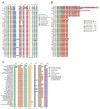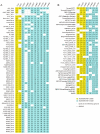Genome-Wide Diversity Analysis of African Swine Fever Virus Based on a Curated Dataset
- PMID: 36139306
- PMCID: PMC9495133
- DOI: 10.3390/ani12182446
Genome-Wide Diversity Analysis of African Swine Fever Virus Based on a Curated Dataset
Abstract
African swine fever (ASF) is a lethal contagious viral disease of domestic pigs and wild boars caused by the African swine fever virus (ASFV). The pandemic spread of ASF has had serious effects on the global pig industry. Virus genome sequencing and comparison play an important role in tracking the outbreaks of the disease and tracing the transmission of the virus. Although more than 140 ASFV genome sequences have been deposited in the public databases, the genome-wide diversity of ASFV remains unclear. Here we prepared a curated dataset of ASFV genome sequences by filtering genomes with sequencing errors as well as duplicated genomes. A total of 123 ASFV genome sequences were included in the dataset, representing 10 genotypes collected between 1949 and 2020. Phylogenetic analysis based on whole-genome sequences provided high-resolution topology in differentiating closely related ASFV isolates, and drew new clues in the classification of some ASFV isolates. Genome-wide diversity of ASFV genomes was explored by pairwise sequence similarity comparison and ORF distribution comparison. Tandem repeat sequences were found widely distributed and highly varied in ASFV genomes. Structural variation and highly variable poly G or poly C tracts also contributed to the genome diversity. This study expanded our knowledge on the patterns of genetic diversity and evolution of ASFV, and provided valuable information for diagnosis improvement and vaccine development.
Keywords: African swine fever virus; curated dataset; genome sequence diversity; tandem repeat sequences.
Conflict of interest statement
The authors declare that they have no competing interests.
Figures






References
-
- OIE, African Swine Fever. 2022. [(accessed on 10 November 2021)]. Available online: https://www.woah.org/en/disease/african-swine-fever/#ui-id-2.
Grants and funding
LinkOut - more resources
Full Text Sources

